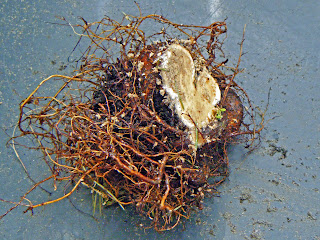I don't usually try to create jin, shari, or uro on tropical trees, for the simple reason that you rarely see those features on tropical trees in nature. In the rainforest, in particular, dead wood rots away quickly.
But I have one tropical tree that I acquired with the specific intent of turning it into a hollow-trunk bonsai. I saw it in Meehan's on-line catalog, and realized that a major flaw could make an interesting feature if my skills were up to it. When my lovely wife asked me what I wanted for Christmas that year, I was ready!
But I have one tropical tree that I acquired with the specific intent of turning it into a hollow-trunk bonsai. I saw it in Meehan's on-line catalog, and realized that a major flaw could make an interesting feature if my skills were up to it. When my lovely wife asked me what I wanted for Christmas that year, I was ready!
